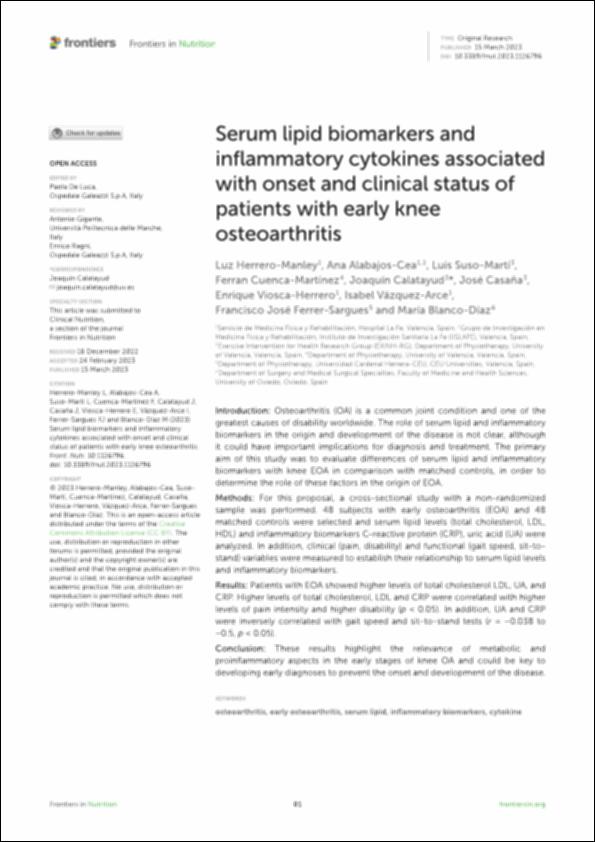Por favor, use este identificador para citar o enlazar este ítem:
http://hdl.handle.net/10637/15200Serum lipid biomarkers and inflammatory cytokines associated with onset and clinical status of patients with early knee osteoarthritis
| Título : | Serum lipid biomarkers and inflammatory cytokines associated with onset and clinical status of patients with early knee osteoarthritis |
| Autor : | Herrero Manley, Luz Alabajos Cea, Ana Suso Martí, Luis Cuenca Martínez, Ferran Calatayud Villalba, Joaquín Casaña, José Viosca Herrero, Enrique Vázquez Arce, Isabel Ferrer Sargues, Francisco José Blanco Díaz, María |
| Materias: | Osteoartritis; Osteoarthritis; Marcadores bioquímicos; Biochemical markers; Rodillas; Knee |
| Editorial : | Frontiers Media |
| Citación : | Herrero-Manley, L., Alabajos-Cea, A., Suso-Martí, L., Cuenca-Martínez, F., Calatayud, J., Casaña, J., Viosca-Herrero, E., Vázquez-Arce, I., Ferrer-Sargues, F.J. & Blanco-Díaz, M. (2023). Serum lipid biomarkers and inflammatory cytokines associated with onset and clinical status of patients with early knee osteoarthritis. Frontiers in Nutrition, vol. 10, art. 1126796 (15 mar.). DOI: https://doi.org/10.3389/fnut.2023.1126796 |
| Resumen : | Introduction: Osteoarthritis (OA) is a common joint condition and one of the greatest causes of disability worldwide. The role of serum lipid and inflammatory biomarkers in the origin and development of the disease is not clear, although it could have important implications for diagnosis and treatment. The primary aim of this study was to evaluate differences of serum lipid and inflammatory biomarkers with knee EOA in comparison with matched controls, in order to determine the role of these factors in the origin of EOA. Methods: For this proposal, a cross-sectional study with a non-randomized sample was performed. 48 subjects with early osteoarthritis (EOA) and 48 matched controls were selected and serum lipid levels (total cholesterol, LDL, HDL) and inflammatory biomarkers C-reactive protein (CRP), uric acid (UA) were analyzed. In addition, clinical (pain, disability) and functional (gait speed, sit-to-stand) variables were measured to establish their relationship to serum lipid levels and inflammatory biomarkers. Results: Patients with EOA showed higher levels of total cholesterol LDL, UA, and CRP. Higher levels of total cholesterol, LDL and CRP were correlated with higher levels of pain intensity and higher disability (p < 0.05). In addition, UA and CRP were inversely correlated with gait speed and sit-to-stand tests (r = -0.038 to -0.5, p < 0.05). Conclusion: These results highlight the relevance of metabolic and proinflammatory aspects in the early stages of knee OA and could be key to developing early diagnoses to prevent the onset and development of the disease. |
| URI : | http://hdl.handle.net/10637/15200 |
| Derechos: | Open Access http://creativecommons.org/licenses/by/4.0/deed.es |
| ISSN : | 2296-861X (Electrónico) |
| Fecha de publicación : | 15-mar-2023 |
| Centro : | Universidad Cardenal Herrera-CEU |
| Aparece en las colecciones: | Dpto. Enfermería y Fisioterapia |
Los ítems de DSpace están protegidos por copyright, con todos los derechos reservados, a menos que se indique lo contrario.


